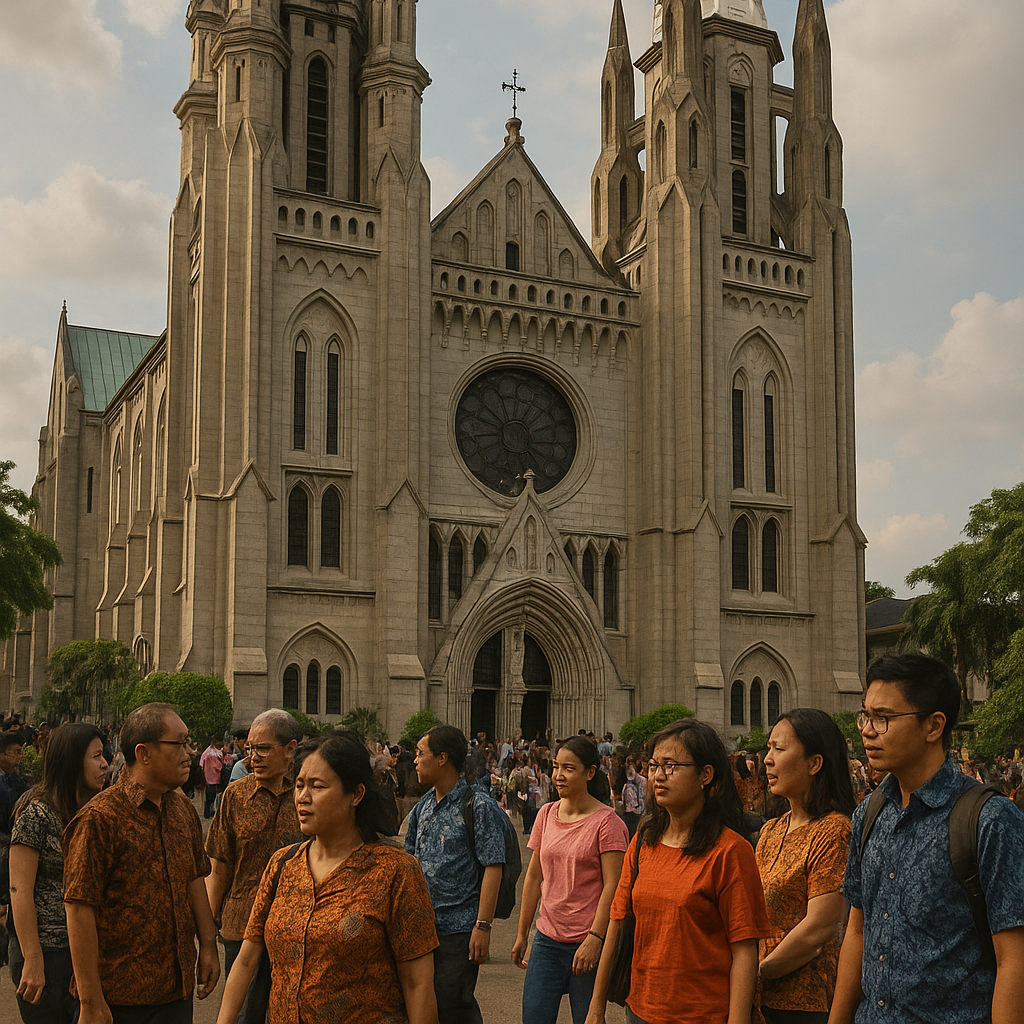Jakarta Cathedral: History, Architecture, and Its Role in the Development of Catholicism in Indonesia
theolingua.id – The Jakarta Cathedral, officially known as the Church of St Mary Assumed into Heaven, is one of the historic buildings that is the centre of Catholic activity in Indonesia. Located at Jalan Katedral No. 7, Central Jakarta, the church has been a silent witness to the development of the Catholic religion since the Dutch colonial period. Its existence reflects the long journey of Catholics in defending their beliefs in the midst of changing times.
Construction of this church began in the early 19th century, when the Dutch East Indies government finally allowed Catholics to have an official place of worship in 1829. Previously, during VOC domination, the practice of Catholicism was prohibited and the faithful had to worship in secret. With the granting of this permit, Catholics in Batavia began to build the first church on this site as a symbol of their freedom to worship.
However, the first church did not last long. In 1890, the building suffered a major fire that destroyed most of its structure. This condition encouraged greater reconstruction efforts to ensure the continuity of a place of worship for Catholics in Jakarta.
The current church building is the result of a reconstruction that was completed on 21 April 1901. With its distinctive Neo-Gothic architecture, the church is designed with impressive artistic details, reflecting the strong influence of European architecture and making it one of the historical icons in Jakarta.
Architecture and Uniqueness of the Building
One of the main attractions of the Jakarta Cathedral Church is its Neo-Gothic architectural style, which is commonly found in large churches in Europe. This style is characterised by the pointed shapes of the windows, roof and doors, which give it a majestic and sacred impression. In addition, the distinctive Neo-Gothic ornamental details, such as intricate carvings and coloured stained glass, add to the beauty of the church’s architecture.
The design of this building was made by Father Antonius Dijkmans, an architect from the Netherlands, who adapted typical elements of European architecture to create a church that not only functions as a place of worship, but also as a strong spiritual symbol. The beauty and solidity of the church’s structure is proof of the architectural expertise of its time, making it one of the historic landmarks in Jakarta.
Some of the uniqueness of the Jakarta Cathedral include:
- Twin Towers: The church has three main towers, namely the David Tower, the Ivory Tower, and the Angelus Dei Tower. The tallest tower reaches a height of 60 metres.
- Historic Interior: The interior of the church has a magnificent altar, beautiful stained glass, and wooden benches that have been well-preserved since the beginning of its construction.
- Cathedral Museum: Inside the church complex, there is a museum that houses various artefacts and historical documentation of the development of Catholicism in Indonesia.
The Role of the Cathedral Church in the Development of Catholicism in Indonesia
As the centre of the Archdiocese of Jakarta, the Cathedral Church plays an important role in the spread of Catholicism in Indonesia. Besides being the main place of worship, the church is also the location for various major religious celebrations. One of the most anticipated celebrations is the Christmas and Easter Mass, where Catholics from various regions gather to celebrate this sacred moment. This event is also often attended by high-ranking state officials, showing respect for religious diversity in Indonesia.
More than just a place of worship, the Jakarta Cathedral Church is also a centre for pastoral and social activities for Catholics. Various religious, educational and social assistance programmes are run from this church to help the surrounding community. This active involvement in social activities makes the Cathedral Church a symbol of care and devotion to others.
In addition, the Jakarta Cathedral Church has an important role in interfaith dialogue, especially because of its location directly opposite the Istiqlal Mosque. The proximity of these two iconic buildings is often a symbol of tolerance and harmony between religious communities in Indonesia. The collaboration between the church and the mosque in various religious and social activities further reinforces the message of peace and unity in a diverse society.
The existence of the Cathedral Church in the heart of the capital also makes it an important destination for tourists, both local and foreign. Many visitors come to admire its architecture and history, as well as to feel the thick religious atmosphere. With all these roles, the Jakarta Cathedral Church continues to bear witness to the development and diversity of religious life in Indonesia.
Closing
The Jakarta Cathedral is not only a place of worship for Catholics, but also a historical legacy that reflects the long journey of Catholicism in Indonesia. Standing majestically with its Neo-Gothic architecture, the church is a historic icon that attracts many people, both Catholics and tourists interested in its historical value.
Apart from being a religious centre, the Jakarta Cathedral Church also plays a role in various social activities and interfaith dialogue. Its location directly opposite the Istiqlal Mosque makes it a true symbol of tolerance and harmony among religious communities in Indonesia. These two places of worship often hold joint activities as an effort to strengthen relations between religious communities.
Not only that, the Cathedral Church is also the venue for various major celebrations in the Catholic calendar, such as Christmas and Easter Masses, which are always packed with congregations from various regions. These celebrations are also an opportunity for deep spiritual reflection for Catholics who come to strengthen their faith.
With its historical value, magnificent architecture, and its role in maintaining social harmony, the Jakarta Cathedral Church remains a must-visit destination for anyone who wants to understand more about the history and development of Catholicism in Indonesia.







